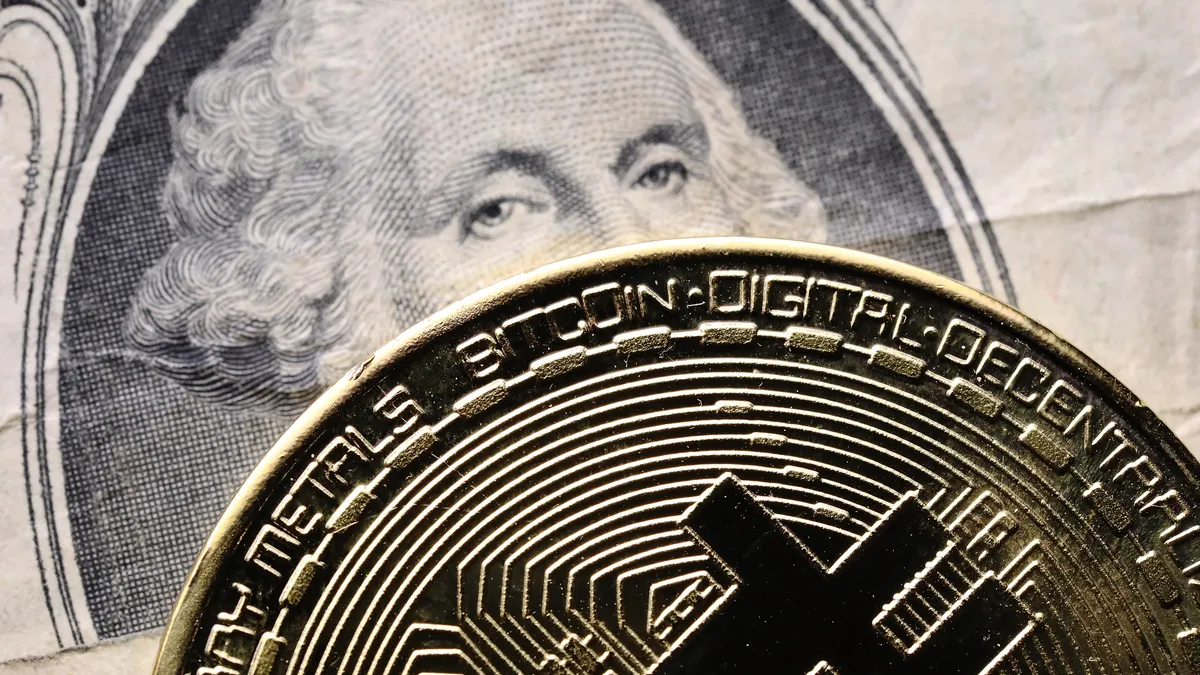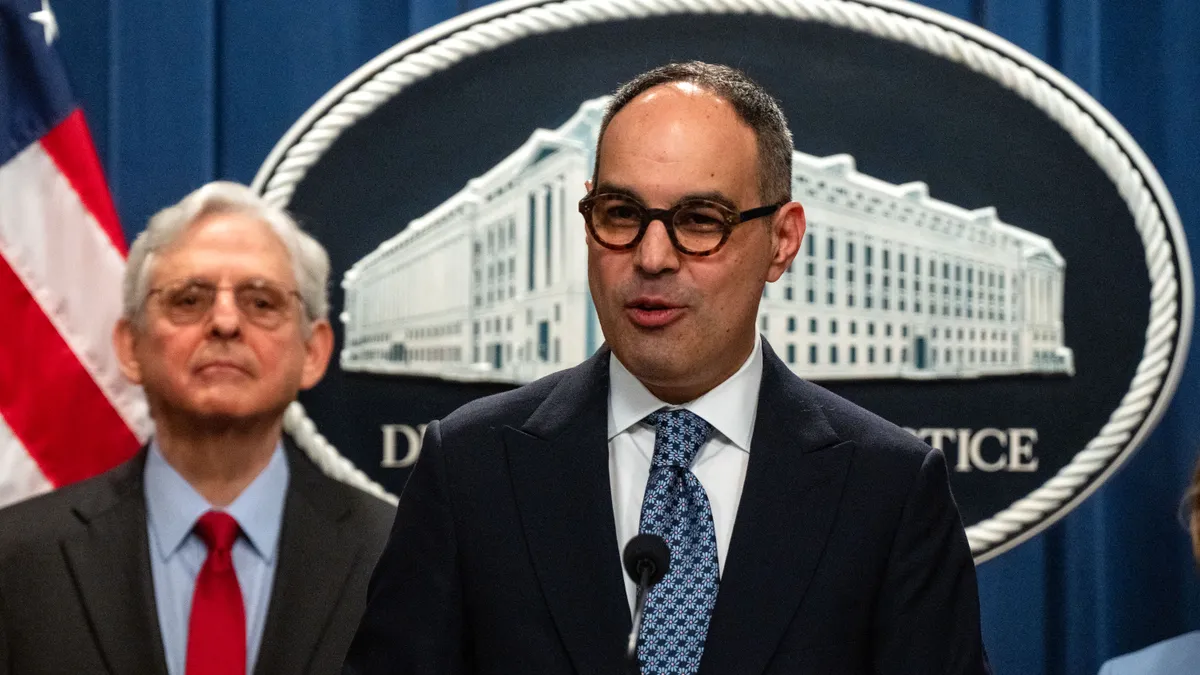As major banks and card companies begin offering an array of cryptocurrency products and services, whether consumers will adopt crypto as payment vehicles remains an open question.
Companies are making it easier than ever for consumers to pay with crypto at the point of sale. Until recently, paying with crypto was a complicated endeavor that involved enduring delays waiting for transactions to clear on a blockchain, if retailers were even willing to accept it. And the volatility of digital assets was difficult to manage for retailers and consumers alike.
But over the past year, a growing number of mainstream payment providers and card networks are making it easier for retailers to accept crypto. As a result, businesses are increasingly adding cryptocurrencies as payment options and making a bet that consumer uptake will grow. The persistent rise in crypto value — more than $2 trillion worldwide, or about equal to the value of greenbacks in circulation — makes it worth their while to encourage consumers to spend from their increasingly bulging digital wallets.
Two key factors underpin companies’ bets on crypto payments: a growing number of consumers holding crypto — unlike five years ago — and technology that’s made it easier than ever to transact with crypto. With an increasing number of customers holding crypto assets, easy crypto payments are a natural next step, companies said.
“There was sort of a mismatch between the crypto world, which is a real-time world, and the traditional kind of bank transfer world,” said Randy Kern, chief technology officer at card issuing and processing firm Marqeta. “[Now] we are able to provide an experience that’s much more seamless.”
Growing acceptance
In recent months, major payments companies have broadened the ability for merchants to accept cryptocurrencies.
Purchase, New York-based Mastercard launched a partnership with digital asset exchange Bakkt to allow partner merchants, banks and fintech firms to accept payments in crypto. The tie-up also allows for the delivery of crypto rewards to consumers. Mastercard’s partnership with Bakkt lets merchants and other partners accept crypto while Bakkt carries out custodial services. In addition, Mastercard this month tapped other partners to create crypto-linked credit, debit and prepaid cards in the Asia-Pacific region that can be used for converting crypto to fiat currency for spending.
Also in October, payments software firm ACI Worldwide announced a tie-up with RocketFuel Blockchain to allow more than 50 cryptocurrencies to be accepted through one click at client e-commerce checkouts, with no fees.
Marqeta last month began powering Visa crypto debit cards from Bakkt, Coinbase and Fold. Marqeta’s technology enables crypto transactions to take place at speeds similar to those for fiat transactions.
Visa, which said it partners with 50 crypto platforms on card programs, announced in July that more than $1 billion was spent on crypto-linked Visa cards in the first half of 2021.
"A Visa credential — whether physical or virtual" — is becoming the preferred mechanism for the increasing number of consumers who have crypto when they want to actually access that value in spending,” said Cuy Sheffield, head of crypto at Visa.
Payments firms and merchants that spoke with Payments Dive said the addition of crypto as a payments vehicle is a response to consumer demand, and an opportunity to grow basket sizes. Crypto payments software from third-party firms allow for quick conversion of crypto payments to fiat currency, letting merchants make or receive payments without holding the digital assets.
Merrick Theobald, vice president of marketing at crypto payment processor BitPay, said the availability of crypto transactions drives up average order value and can help merchants tap into new customer bases. BitPay charges a flat fee of 1% of transactions for fiat conversions in the background and completes crypto payment transactions.
“Sometimes a concern with Bitcoin is with the volatility, but that's also why a merchant would want to partner with BitPay, because we manage the volatility — they have nothing to do with the volatility — if they charge $100, they're going to get $100 minus our 1% fee,” he said.
For Atlanta-based BitPay, which said it supports a dozen cryptocurrencies globally, its 1% fee is lower than those charged by major card networks, which can charge more than 2% per transaction. In addition, Theobald said adding crypto payments is a way merchants can attract buyers who typically make larger purchases.
According to a Forrester Research study commissioned by BitPay last year, crypto adopters have an average order value of $450, compared to $200 for non-crypto users. In addition, of customers paying through BitPay, 40% were new customers, demonstrating a major opportunity to broaden customer reach, Forrester reported.
Alongside growing acceptance of crypto transactions at checkout, payments firms say the technology is allowing the transactions to settle faster, on a time frame similar to regular card transactions. Compared to settlement times for crypto payments processed on a blockchain without an intermediary, working through Marqeta cuts processing time from days to minutes.
“Instead of a multiday process, now from your wallet and the associated card that Marqeta has issued, you're able to — in real time — collapse that whole three-day, multistep process into something that's done entirely behind the scenes. And with your cards, you can effectively go make a purchase in the real world which, from the merchant’s perspective, looks like a traditional fiat currency purchase,” Kern said.
Visa, the biggest card company, and No. 2 Mastercard are pitching crypto payments that offer no more friction than a traditional card transaction.
“There are very few merchants who are enabled to directly accept Bitcoin over the Bitcoin blockchain because it's difficult for them to do so — it requires new infrastructure, and they have to upgrade their point-of-sale terminals,” Sheffield said. “It can take 10 minutes for a transaction to confirm, and then there's the volatility that merchants have to figure out.”
By contrast, Visa allows for crypto acceptance at 70 million merchants, where the balance of crypto is automatically converted to fiat currencies on the back end, Sheffield said.
Will consumers opt in?
Despite a growing number of options for consumers to pay with crypto, it’s too early to assess the level of crypto use at checkouts, though practitioners agree adoption isn’t huge at this point.
Sheffield acknowledged that Visa’s $1 billion in payment volume from crypto-linked cards represents a small percentage of the trillions of dollars in payment volume Visa processes. (Last year, Visa’s total payments and cash volume was $11.3 trillion.)
Online retailer Overstock made a splash in 2014, when it became one of the first major retailers to accept Bitcoin for purchases. Still, CEO Jonathan Johnson told Payments Dive that Bitcoin sales amount to less than one-quarter of 1% of sales.
Analysts say simply turning on crypto payments isn’t likely to convince large swaths of consumers to use it as a default payment method.
While crypto payment solutions are more readily available, it’s unclear what payment problem they’re solving, said Daniela Hawkins, a payments analyst with research firm Capco. To ensure the flow of crypto payments from the consumer to merchant, the retailer will need to enable them through some sort of established payment rail, she noted.
Crypto payments for everyday purchases also include an additional tax burden, a factor that may deter some consumers from using it. Making a purchase with cryptocurrency — however small — is considered a taxable event because it involves an exchange of value when the buyer sells crypto to initiate the payment. So, in addition to sales tax, the transaction triggers other tax reporting requirements because buying goods with crypto involves a sale of the underlying digital asset.
“The IRS treats cryptocurrency as property, so any time you buy, sell or exchange cryptocurrency, it’s treated as a taxable event,” said Shivani Jain, a certified public accountant and partner at accounting, tax and advisory firm Sax LLP.
Tools to track the tax implications of crypto transactions are evolving. While technology may eventually solve this problem, it takes some leg work for the average consumer to meet tax reporting requirements, she said.
Some argue that companies are adding crypto payment vehicles as a marketing strategy, or as a gesture of support for the crypto ecosystem. But for most consumers, adoption isn’t likely to grow without an additional benefit from paying with crypto, said David True, a partner at payments consultancy PayGility Advisors.
“It’s for the true believers, or people who are really into using crypto and believe in the future of crypto,” said True, referencing those who already use it for everyday payments.
Other people will need different reasons.
“They’ll pay with it if there’s simplicity and they'll pay with it if there's a reward or some sort of benefit attached,” True said.
Indeed, for some consumers, cryptocurrencies as rewards for credit card spending — including offerings from BlockFi, Upgrade and Gemini — seem to be accelerating use of crypto as a payment vehicle. BlockFi’s crypto reward credit card, for example, is reportedly approaching $2 billion in annualized transaction volume since its launch in July.
Still, the ability to garner crypto reward points that grow through card activity is of greater value to the customer than using the card for transactions in crypto, said Kalpesh Kapadia, CEO of Deserve, the card technology company that partnered with Visa and BlockFi on the crypto reward credit card launched last summer.
“People want to hoard Bitcoin [and] people want it to grow,” he said. “It’s like gold. You convert gold into dollars when you want to sell.”
The volatility of cryptocurrencies, he said, may inhibit their use as payment vehicles, but stablecoins — digital currencies tied to the value of a reserve asset such as the U.S. dollar — have potential, he said. Stablecoins, for example, are part of Facebook’s Novi digital currency pilot in the U.S. and Guatemala, which is tapping the stablecoin USDP.
A bet on the future
Companies enabling crypto payments say they want to get in front of the new payment habits of a younger generation that is more open to transacting with crypto, and that they may want more interoperability between their crypto and non-crypto assets.
ACI Worldwide said clients — which include banks, merchants and billers — are asking for crypto payment options because of consumer demand.
“We've been asked, ‘When can my consumers pay for a pizza with it? When can my consumers go to see a movie and pay with cryptocurrency?’” said Debbie Guerra, head of the merchant segment at ACI Worldwide. “I think there is a demographic play with a more mobile-adept, younger buyer.”
People who are buying into crypto, quite literally, want crypto payment capabilities that allow them to be able to more seamlessly transact between their crypto and non-crypto assets.
“Particularly for more millennial and Gen Z consumers, [crypto] is starting to become a mainstream investment, and these consumers want to have access to that liquidity,” Sheffield said. “They're buying Bitcoin so that they can hold it, and they believe that it will appreciate over time — but they still want to be able to have access to that money. They don’t want to have to wait.”

















